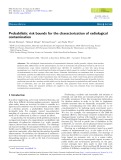
REGULAR ARTICLE
Probabilistic risk bounds for the characterization of radiological
contamination
Géraud Blatman
1
, Thibault Delage
2
, Bertrand Iooss
2,*
, and Nadia Pérot
3
1
EDF Lab Les Renardières, Materials and Mechanics of Components Department, 77818 Moret-sur-Loing, France
2
EDF Lab Chatou, Department of Performance, Industrial Risk, Monitoring for Maintenance and Operations,
78401 Chatou, France
3
CEA Nuclear Energy Division, Centre de Cadarache, 13108 Saint-Paul-lès-Durance, France
Received: 9 December 2016 / Received in final form: 26 May 2017 / Accepted: 19 June 2017
Abstract. The radiological characterization of contaminated elements (walls, grounds, objects) from nuclear
facilities often suffers from too few measurements. In order to determine risk prediction bounds on the level of
contamination, some classic statistical methods may therefore be unsuitable, as they rely upon strong
assumptions (e.g., that the underlying distribution is Gaussian) which cannot be verified. Considering that a set
of measurements or their average value come from a Gaussian distribution can sometimes lead to erroneous
conclusions, possibly not sufficiently conservative. This paper presents several alternative statistical approaches
which are based on much weaker hypotheses than the Gaussian one, which result from general probabilistic
inequalities and order-statistic based formulas. Given a data sample, these inequalities make it possible to derive
prediction intervals for a random variable which can be directly interpreted as probabilistic risk bounds. For the
sake of validation, they are first applied to simulated data generated from several known theoretical
distributions. Then, the proposed methods are applied to two data sets obtained from real radiological
contamination measurements.
1 Introduction
In nuclear engineering, as for most industrial domains, one
often faces difficult decision-making processes, especially
when safety issues are involved. In order to consider in a
rigorous and consistent way all environment uncertainties
in a decision process, a probabilistic framework offers
invaluable help. For example, typical non-exhaustive
sampling of a process or object induces uncertainty that
needs to be understood in order to control its effects.
In particular, the estimation of risk prediction bounds is
an important element of a comprehensive probabilistic risk
assessment of radioactive elements (e.g., walls, grounds,
objects) derived from the nuclear industry. The radiologi-
cal characterization of contaminated elements in a nuclear
facility may be difficult because of practical and/or strong
operation constraints, often limiting the number of possible
measurements. Nevertheless, the estimation of radioactiv-
ity levels is essential to assess the risk of exposure of nuclear
dismantling operator, as well as the risk of environment
contamination [1].
Performing a realistic and reasonable risk estimate is
essential, not only from an economic perspective, but also
for public acceptance. First, this is important information
for decision makers in order to be able to implement
suitable measures that are financially acceptable. Never-
theless, overestimating the risk often turns out to be
counterproductive by inducing much uncertainty and a
loss of confidence in public authorities from the population.
We cite, for example, the management of the 2009 flu
epidemic (H1N1), where many countries’authorities had a
disproportionate reaction with regard to real risk, due to
the World Health Organization’s (WHO) poorly managed
forecasts [2]. This led to public loss of confidence in the
authorities, in vaccines, and in pharmaceutical companies
as well as an enormous waste of public resources.
Drawing up a radiological inventory based on a small
number of measurements (e.g., in the order of 10) is a
particularly difficult statistical problem. The shortage of
data can lead either to a coarse over-estimation, which has
large impact on economic cost, or to a coarse under-
estimation, which has an unacceptable impact in terms of
public health and environment protection. In the past,
several attempts have been made to deal with such
problems. For instance, Perot and Iooss [3] focused on the
problem of defining a sampling strategy and assessing the
* e-mail: bertrand.iooss@edf.fr
EPJ Nuclear Sci. Technol. 3, 23 (2017)
©G. Blatman et al., published by EDP Sciences, 2017
DOI: 10.1051/epjn/2017017
Nuclear
Sciences
& Technologies
Available online at:
http://www.epj-n.org
This is an Open Access article distributed under the terms of the Creative Commons Attribution License (http://creativecommons.org/licenses/by/4.0),
which permits unrestricted use, distribution, and reproduction in any medium, provided the original work is properly cited.





















